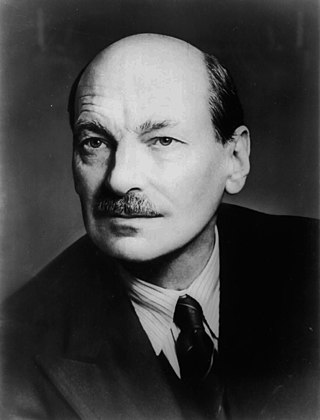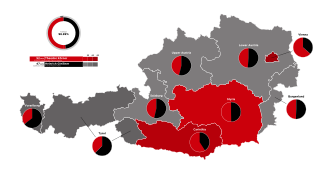
Politics in Austria reflects the dynamics of competition among multiple political parties, which led to the formation of a Conservative-Green coalition government for the first time in January 2020, following the snap elections of 29 September 2019, and the election of a former Green Party leader to the presidency in 2016.

The Austrian People's Party is a Christian-democratic and liberal-conservative political party in Austria.

The 1945 United Kingdom general election was a national election held on Thursday 5 July 1945, but polling in some constituencies was delayed by some days, and the counting of votes was delayed until 26 July to provide time for overseas votes to be brought to Britain. The governing Conservative Party sought to maintain its position in Parliament but faced challenges from public opinion about the future of the United Kingdom in the post-war period. Prime Minister Winston Churchill proposed to call for a general election in Parliament, which passed with a majority vote less than two months after the conclusion of the Second World War in Europe.

The Communist Party of Austria is a communist party in Austria. Established in 1918 as the Communist Party of German-Austria (KPDÖ), it is one of the world's oldest communist parties. The KPÖ was banned between 1933 and 1945 under both the Austrofascist regime and the Nazi German administration of Austria after the 1938 Anschluss.

The Greens – The Green Alternative is a green political party in Austria.

The Liberal Forum was a centrist, liberal political party in Austria. The party was active from February 1993 to January 2014, when the party merged into NEOS – The New Austria.

Social Democracy, known as the Czech Social Democratic Party until 10 June 2023, is a social-democratic political party in the Czech Republic. Sitting on the centre-left of the political spectrum and holding pro-European views, it is a member of the Party of European Socialists, the Socialist International, and the Progressive Alliance. Masaryk Democratic Academy is the party-affiliated's think tank.

On the federal level, there are two main elections in Austria: presidential elections and elections to determine the composition of the National Council (Nationalrat), the lower house of Austria's bicameral Parliament. The upper house, the Federal Council consists of delegates from the states and is not directly elected. These elections are governed by federal law, which also applies to European Parliament elections in Austria.

Parliamentary elections were held in Austria on 10 May 1959. Although the Socialist Party received the most votes, the Austrian People's Party retained a bare one-seat plurality. The Communist Party of Austria lost its remaining three seats and has not returned to the National Council since. Voter turnout was 94%. The grand coalition that had governed the country since 1945 remained in office, with People's Party leader Julius Raab as Chancellor and Socialist leader Bruno Pittermann as Vice-Chancellor.

Parliamentary elections were held in Austria on 22 February 1953. They were the elections in which the Socialist Party received the most votes since 1920. However, the Austrian People's Party won the most seats. The grand coalition between the two parties was continued with Julius Raab replacing Leopold Figl as Chancellor of Austria, who had had to resign after facing criticism from his own party, and Adolf Schärf of the Socialist Party remaining Vice Chancellor.

Parliamentary elections were held in Austria on 25 November 1945, the first after World War II. The elections were held according to the Austrian election law of 1929, with all citizens at least 21 years old eligible to vote, however former Nazis were banned from voting, official sources putting their numbers at around 200,000.

The 2005 Styrian state election was held on 2 October 2005 to elect the members of the Landtag of Styria.

The Freedom Party of Austria is a national-conservative, right-wing populist, political party in Austria. It has been led by Herbert Kickl since 2021. It is the third largest of five parties in the National Council, with 30 of the 183 seats, and won 16.2% of votes cast in the 2019 legislative election. It is represented in all nine state legislatures, and a member of two state cabinets. On a European level, the FPÖ is a founding member of the Identity and Democracy Party and its three Members of the European Parliament (MEPs) sit with the Identity and Democracy (ID) group.

Austria, formally the Republic of Austria, is a landlocked country in Central Europe, lying in the Eastern Alps. It is a federation of nine federal states, one of which is the capital, Vienna, the most populous city and federal state. Austria is bordered by Germany to the northwest, Czech Republic to the north, Slovakia to the northeast, Hungary to the east, Slovenia and Italy to the south, and Switzerland and Liechtenstein to the west. The country occupies an area of 83,900 km2 (32,394 sq mi) and has a population of around 9 million.

Presidential elections were held in Austria in 1951, the first time that the President of Austria had been elected by popular vote. A first round of voting was held on 6 May, and with no candidate achieving a majority of the votes, a second round was held on 27 May between the top two candidates, Mayor of Vienna, Theodor Körner representing the Socialist Party's, and Upper Austria Governor Heinrich Gleißner of the Austrian People's Party. Although Gleißner received the most votes in the first round Körner won the runoff with 52% of the vote.

The Reichstag, officially the Greater German Reichstag after 1938, was the national parliament of Nazi Germany from 1933 to 1945. Following the Nazi seizure of power and the enactment of the Enabling Act of 1933, it functioned purely as a rubber stamp for the actions of Adolf Hitler's dictatorship — always by unanimous consent — and as a forum to listen to Hitler's speeches. In this purely ceremonial role, the Reichstag convened only 20 times, the last on 26 April 1942. The President of the Reichstag throughout this period was Hermann Göring.

Legislative elections were held in Austria on 29 September 2013 to elect the 25th National Council, the lower house of Austria's bicameral parliament.

The Social Democratic Party of Austria is a social-democratic political party in Austria. Founded in 1889 as the Social Democratic Workers' Party of Austria and later known as the Socialist Party of Austria from 1945 until 1991, the party is the oldest extant political party in Austria. Along with the Austrian People's Party (ÖVP), it is one of the country's two traditional major parties. It is positioned on the centre-left on the political spectrum.

NEOS – The New Austria and Liberal Forum is a liberal political party in Austria. It was founded as NEOS – The New Austria in 2012. In 2014, NEOS merged with Liberal Forum and adopted its current name.
Since its foundation in 1889, the Social Democratic Party has often been one of the main political forces in Austria. At the start of the First World War it was the strongest party in parliament, and on the ending of that war in 1918 the party leader Karl Renner became chancellor of the First Republic. The party lost power in 1920, but retained a strong base of support in the capital Vienna. A period of rising political violence culminated in the banning of the Social Democratic Party under the Austrofascist dictatorship (1934–38).

























